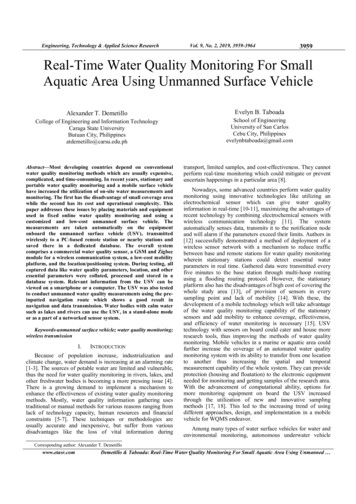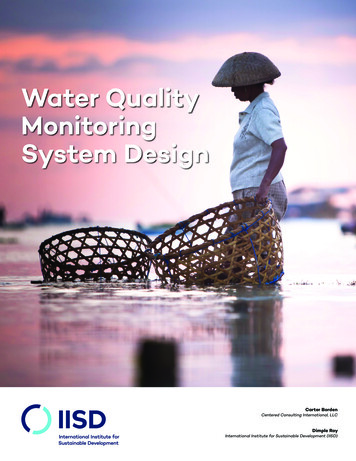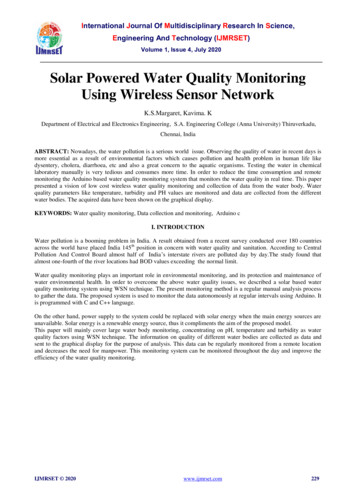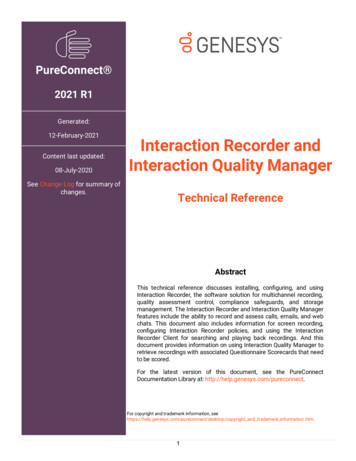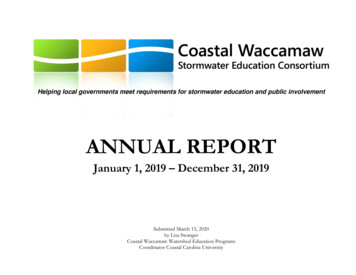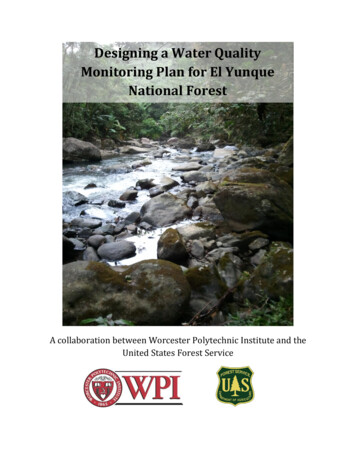
Transcription
Designing a Water QualityMonitoring Plan for El YunqueNational ForestA collaboration between Worcester Polytechnic Institute and theUnited States Forest Service
CXP-PR15Designing a Water Quality MonitoringPlan for El Yunque National ForestAn Interactive Qualifying Project ReportSubmitted to the Faculty ofWORCESTER POLYTECHNIC INSTITUTEIn partial fulfillment of the requirements for theDegree of Bachelor of ScienceSponsoring Agency: El Yunque National ForestSubmitted to:On-Site Liaison: Pedro Rios, Ecosystem Management Team LeaderProject Advisor: R. Creighton Peet, Ph.D., WPI ProfessorProject Co-advisor: Aarti Madan, Ph.D., WPI ProfessorSubmitted by:Frank BrutonKassondra HickeyXavier MillerRichard ValdesDate: May 2, 2012
AbstractThe US Forest Services needs a sustainable method of measuring the water quality of El YunqueNational Forest’s wild and scenic rivers. Our project developed a monitoring plan for these rivers that isboth accurate and cost efficient. Based upon the opinions of water quality experts and our own on-siteanalysis, our final plan includes seven sampling sites on three rivers. We recommend the use of a multiparameter probe to reliably collect water measurements and calculated one year of monitoring will costapproximately 4,000.ii
AcknowledgementsThe success of this project was largely due to the accommodating and supportive nature of allthe staff at El Yunque National Forest. Nearly everyone we met was personable and willing to help makeour project successful. In particular, we would like to thank Anastasio “Baby” Gomez and BenjaminFuentes who took us to all of the sampling sites. Our liaison, Pedro Rios, deserves a big thank you as wellfor his work in coordinating and helping direct the project. ¡Gracias a todos!We also received valuable help and guidance during our research and interview stage from theUnited States Geological Survey, Professor Bill McDowell of the University of New Hampshire andProfessor Paul Mathisen of WPI. These interactions ultimately helped us finalize almost every aspect ofour monitoring plan.Lastly, we would like to thank our advisors, Professors Aarti Madan and R. Creighton Peet, fortheir guidance and helpful comments throughout the last two terms. This report would not be assuccinct and well composed if it were not for their feedback on our weekly drafts.iii
Authorship TableAbstract . ValdesAcknowledgements. MillerAuthorship Table . AllTable of Contents . HickeyTable of Figures and Tables. HickeyExecutive Summary. Error! Bookmark not defined.All1.0 Introduction . All2.0 Background . All2.1 Freshwater Ecosystems. Hickey, Miller2.1.1 Importance of Water Quality . Hickey, Miller2.1.2 Societal threats to freshwater ecosystems . Hickey, Miller2.2 Monitoring River and Stream Water Quality . Miller, Valdes2.2.1 Designing a Water Quality Plan . Miller, Valdes2.2.2 Monitoring Standards . Miller2.2.3 Current Technologies and Equipment . Miller2.2.4 Interpreting Results. Miller2.3 Non-formal Education . Hickey, Bruton2.3.1 Instructional Guides . Hickey, Bruton2.3.2 Professional and Vocational Training. Bruton2.4 El Yunque National Forest . Hickey2.4.1 El Yunque’s Wild and Scenic Rivers . Hickey2.5 Summary . Error! Bookmark not defined.All3.0 Methods . All3.1 Identify Current Methodologies and Technologies . Miller, Valdes3.1.1 Correspondence with Local Experts. Miller, Valdes3.1.2 Interviews with USFS Staff . Error! Bookmark not defined.3.2 Design and Testing of a Water Quality Monitoring PlanError! Bookmark not defined.Bruton, Miller3.2.1 Variable Selection . Bruton, Miller3.2.2 Sampling Locations . Bruton, Miller3.2.3 Interpretation of Results . Bruton, Miller3.3 Training Program Development . Hickeyiv
3.4 Summary . Hickey4.0 Results & Analysis . All4.1 Analysis of Sampling Locations . Valdes4.1.1 Finalized Sampling Locations . Valdes4.1.2 Locations’ Accessibility and Frequency of Future Testing . Valdes4.2 Analysis of Water Quality Results . Hickey, Miller4.2.1 Visual Observations. Miller4.2.2 Instrument Readings . Hickey, Miller4.2.3 Comparison to Puerto Rico EPA Water Quality Standards Error! Bookmark not defined.Hickey,Miller4.3 Cost Analysis . Hickey, Error! Bookmark not defined.4.3.1 Cost of Implementation . Error! Bookmark not defined.4.3.2 Benefit of a Water Quality Plan . Error! Bookmark not defined.4.4 Training Program. Error! Bookmark not defined.Bruton5.0 Conclusions & Recommendations .Error! Bookmark not defined.Bruton, Valdes5.1 Conclusion . Valdes5.2 Recommendations for the water quality monitoring plan . Error! Bookmark not defined.5.3 Recommendations for future training .Error! Bookmark not defined.ValdesReferences . Error! Bookmark not defined.AllAppendix A: Sponsor Description – US Forest Service. Error! Bookmark not defined.MillerAppendix B: Professor Mathisen Interview . Bruton, ValdesAppendix C: Professor McDowell Interview . Error! Bookmark not defined.MillerAppendix D: USGS Interview . Error! Bookmark not defined.AllAppendix E: USFS Interview . Error! Bookmark not defined.AllAppendix F: Stream Quality Data .Error! Bookmark not defined.HickeyAppendix G: Time To Sampling Locations & Sampling Schedule . Error! Bookmark not defined.AllAppendix H: Wild and Scenic River Map . Error! Bookmark not defined.AllAppendix I: Cost Analysis Calculations . Error! Bookmark not defined.MillerAppendix J: Monitoring Plan Training Pamphlet . .Allv
Table of ContentsAbstract . iiAcknowledgements. iiiAuthorship Table . ivTable of Contents . viTable of Figures and Tables. viiiExecutive Summary. ix1.0 Introduction . 12.0 Background . 32.1 Freshwater Ecosystems. 32.1.1 Importance of Water Quality . 32.1.2 Societal threats to freshwater ecosystems . 42.2 Monitoring River and Stream Water Quality . 52.2.1 Designing a Water Quality Plan . 52.2.2 Monitoring Standards . 62.2.3 Current Technologies and Equipment . 72.2.4 Interpreting Results. 92.3 Non-formal Education . 102.3.1 Instructional Guides . 102.3.2 Professional and Vocational Training. 112.4 El Yunque National Forest . 112.4.1 El Yunque’s Wild and Scenic Rivers . 122.5 Summary . 143.0 Methods . 153.1 Identify Current Methodologies and Technologies . 153.1.1 Correspondence with Local Experts. 153.1.2 Interviews with USFS Staff . 163.2 Design and Testing of a Water Quality Monitoring Plan . 163.2.1 Variable Selection . 163.2.2 Sampling Locations . 183.2.3 Interpretation of Results . 193.3 Training Program Development . 19vi
3.4 Summary . 194.0 Results & Analysis . 204.1 Analysis of Sampling Locations . 204.1.1 Finalized Sampling Locations . 204.1.2 Locations’ Accessibility and Frequency of Future Testing . 224.2 Analysis of Water Quality Results . 234.2.1 Visual Observations. 234.2.2 Instrument Readings . 244.2.3 Comparison to Puerto Rico EPA Water Quality Standards . 254.3 Cost Analysis . 264.3.1 Cost of Implementation . 264.3.2 Benefit of a Water Quality Plan . 274.4 Training Program. 275.0 Conclusions & Recommendations . 295.1 Conclusion . 295.2 Recommendations for the Water Quality Monitoring Plan. 305.3 Recommendations for Future Training . 30References . 31Appendix A: Sponsor Description – US Forest Service. 34Appendix B: Professor Mathisen Interview . 36Appendix C: Professor McDowell Interview . 37Appendix D: USGS Interview . 39Appendix E: USFS Interview Results . 40Appendix F: Stream Quality Data . 41Appendix G: Time to Sampling Locations & Sampling Schedule . 44Appendix H: Wild and Scenic River Map . 46Appendix I: Cost Analysis Calculations . 47Appendix J: Monitoring Plan Training Pamphlet . 49vii
Table of Figures and TablesFiguresFigure 1: A Typical Water Quality Monitoring Station . 8Figure 2: The HANNA HI 9828 multi-parameter probe. 17Figure 3: Eliminated Sampling Site - Mameyes Estuary . 21Figure 4: Eliminated Sampling Site - La Mina Falls. 21Figure 5: Locations of Finalized Sampling Locations . 22Figure 6: The US Forest Service Organizational Structure . 34Figure 7: The Management Team at El Yunque National Forest . 35TablesTable 1: Times to Each Sampling Point and Suggested Sampling Frequencies . 23Table 2: Water Quality Readings at Each Site . 24Table 3: EPA Standards and El Yunque's Rivers Statuses . 25Table 4: Acquired USFS Cost Information . 26viii
Executive SummaryFreshwater ecosystems are sensitive to change and can suffer from physical disturbances as wellas pollutants (Dodds, 2002). These aquatic ecosystems have significant benefits in that they providepotable water, have significant monetary value, and allow for the production of crops. Freshwaterenvironments also provide a habitat for many species of animals and plants. These are just a few of thebenefits that can be obtained from healthy freshwater ecosystems.Tropical forests are home to the greatest biological diversity in the world, mostly due to theirstructural complexity (Terborgh, 1992). El Yunque National Forest (2008), the only tropical forest in theU.S. National Forest System, is similarly diverse in that it has 500 native plants and animals. In anattempt to protect this unique tropical environment, the United States Department of Agriculture(2008) designated three of El Yunque’s rivers as being “wild and scenic”. These pristine rivers—the RíoMameyes, Río de la Mina, and Río Icacos—are home to endangered plants and animals that rely on thedelicate ecosystem in which they live. Given these unique flora and fauna, the purity of the Forest’sstreams and rivers is of the utmost importance. El Yunque National Forest has made it clear thatestablishing an effective monitoring program is necessary to ensure that the aforementioned aquaticenvironments remain at a high quality.The goal of this project was to identify and recommend a sustainable method of monitoring thewater quality of El Yunque National Forest’s wild and scenic rivers. In order to successfully andeffectively accomplish this task we created three objectives: To determine an up-to-date, feasible method of monitoring the water quality; To determine the best training methods for USFS field personnel so water qualitymonitoring can be correctly carried out in the future; To develop and recommend a plan for making water testing a sustainable practice.Through a literature review and several interviews with local experts, we determined how bestto design and execute a water-sampling plan for the wild and scenic rivers in El Yunque. Specifically,these interviews helped us decide which equipment to use and which types of variables would be bestto monitor. When deciding on these details, we had to ensure the proposed plans were economicallysustainable and efficient for El Yunque National Forest. Ultimately we decided to use a multi-parametersampling probe in our water quality monitoring plan due to the equipment’s relatively low price, highix
accuracy and speed of sampling. The particular equipment we used, a HANNA HI 9828 probe, allowed usto sample several important quality variables such as pH, dissolved oxygen, salinity, and dissolved solids.We conducted one week of field testing in the forest to identify the most desirable samplingpoints on each stream. We selected the seven sampling points by taking into account various factorssuch as possible disruptions to tourist activities, distance and time spent to reach each location; we alsoconsidered whether the testing results would be representative of the entire stream. One location, theBisley sampling point, ought to be sampled less frequently due to the travel challenges and timedemands required to reach this wild portion of the Rio Mameyes. We recommend monitoring the othersix sampling points four to six times per year due to their accessibility and potential to be sampled overthe course of a single day.After finalizing the water quality monitoring plan we conducted a training session to inform thestaff of El Yunque National Forest on how to properly conduct water quality tests. We decided to give aninteractive presentation, emphasizing common sampling mistakes and points of caution to ensure ElYunque’s water quality results are reliable. This training also incorporated a hands-on portion with theequipment, allowing the trainees to navigate the menus, explore the various features and ask anyquestions they had. We also developed a pamphlet for the equipment explains the proper usage of themulti-parameter probe. The use of both a training session and the development of a short easy-to-readbrochure will help ensure that reliable and accurate water quality results are achieved in the future.Once all of the field data had been collected, we were able to conduct a preliminary analysis ofthe water quality results. In the five stream sites sampled there was a high volatility in several importantparameters; however, there were no clear trends of diminishing water quality when comparing scenicand recreational areas on the rivers. Additional testing over the course of a year will need to beconducted to assess whether there is any trend or causal relationship visible amongst the sampling sites.Most importantly, all of the sites sampled passed Puerto Rico Class SD water quality standards, meaningthat both Rio Mameyes and Rio Icacos are acceptable for use as public water supplies and forrecreational purposes.By making use of the information collected in our site visits we were able to calculate how muchit would cost for the forest to implement our program. We determined that a water quality monitoringplan, inclusive of equipment, labor and vehicle costs, could be implemented for one year for under 8,000. A large portion of this cost is attributed to the equipment that must be purchased in order tox
conduct the testing. Fortunately this is a one-time cost, so each future year of testing would only bebetween 2,800 and 3,800 depending upon the frequency of testing undertaken.RecommendationsThe result of our project is a solid framework for future water sampling that can be used toassess El Yunque’s wild and scenic streams and rivers. Assuming sufficient funds are available, werecommend El Yunque National Forest do the following to ensure the forest’s wild and scenic riversremain pristine: Implement a water quality monitoring plan using the recommended sampling points andfrequency; Purchase a multi-parameter water quality probe that includes a probe able to measure nitratesin addition to common key variables (pH, dissolved oxygen, etc.); Establish an annual one-day session for managers and field personnel to discuss water qualityresults and consider necessary steps to correct any problems encountered.The key elements of a water quality monitoring plan are not highly variable and may only needslight adjustments over time to ensure they continually achieve the desired purpose. With trainingmaterials already developed and such a relatively small implementation cost, we believe that our waterquality monitoring system could be easily implemented in other National Forests that wish to assesswhether tourism and other influences are impacting the health of their aquatic ecosystemsxi
1.0 IntroductionImproper management of water can severely harm the flora and fauna that rely on the water tosurvive (Scenic Rivers, 2002). Unfortunately, overuse of freshwater has caused several cities in theUnited States to consider constructing desalination plants to remedy their freshwater shortfall (Yuhas &Daniels, 2007). Animals, unlike humans, must rely on the quality of water supplied from local aquaticecosystems – whether clean or not. This clean water dilemma is an even greater problem in the world’stropical rainforests, where the presence of sensitive and endangered species demands that waterquality be of the highest purity.Freshwater quality is not simply a problem confined to urban areas. Water quality issues arebeginning to impact El Yunque National Forest, a landlocked tropical rainforest in the northeasterncorner of Puerto Rico (USFS, 2008). The Caribbean National Forest Wild and Scenic Rivers Act (2002)designated portions of three of El Yunque’s rivers as wild and scenic for future generations to enjoy.While this increased publicity is good for increasing the number of tourists, the increased amount ofhuman activities and automobile traffic in the National Forest threatens the possibility of maintainingthe water systems in their current pristine state. The rise in tourists, to over 1.2 million visitors in 2010,has highlighted the need to develop ways to test the forest’s wild and scenic rivers, to ensure that thedelicate ecosystems are left undamaged. The vast amount of wildlife and biological diversity within therainforest that could be affected by any change in the ecosystem is substantial (Dodds, 2002; Harker,1993; Head & Heinzman, 1990).The designation of El Yunque’s rivers as wild and scenic means they must be protected for theirinherent value to the environment and for the people living around them. With the increasing popularityof the rainforest, maintaining these rivers in their near untouched state is extremely difficult. Negativeinfluences by tourists can be seen at a recreational site called Puente Roto, in the approximate center ofEl Yunque, which has recorded above average fecal coliform levels (El Yunque, 2008). Additionally, thesame study states that there is also significant pollution coming from neighboring ranches and farms inthe form of fertilizer runoff. This runoff can trigger unhealthy, elevated levels of bacteria and hormonesin local streams. Outside El Yunque National Forest, there is extensive research that focuses on varyingwater quality assessment methods that range in simplicity from a visual evaluation (USDA, 1998), whichexamines factors such as clarity and fish populations, to a bioassay method (Moiseenko, 2004), which1
tests the concentrations of lethal chemicals in the water using laboratory analyses. There has also beenresearch conducted on the evaluation of water quality in other tropical ecosystems, such as in Kenya(Mokaya, Mathooko, & Leichtfried, 2004).In El
The goal of this project was to identify and recommend a sustainable method of monitoring the water quality of El Yunque National Forest's wild and scenic rivers. In order to successfully and effectively accomplish this task we created three objectives: To determine an up-to-date, feasible method of monitoring the water quality;

